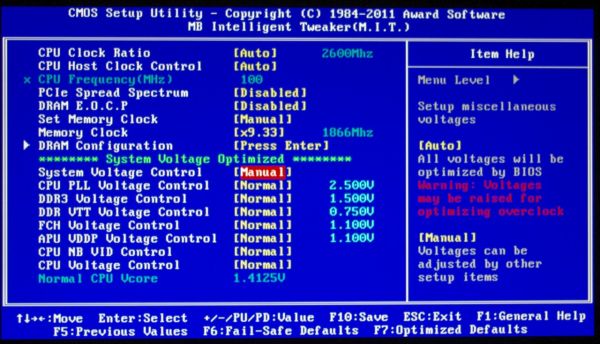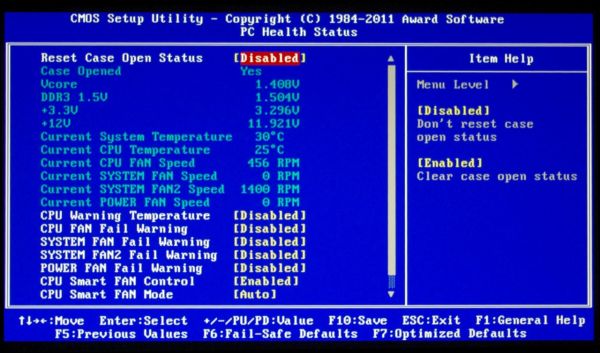ASUS F1A75-V Pro vs. Gigabyte GA-A75-UD4H – Llano at ~$120
by Ian Cutress on November 7, 2011 6:00 AM EST- Posted in
- Motherboards
- Gigabyte
- Asus
- A75
BIOS
Gigabyte is still adhering to the old-fashioned BIOS look. We will not get any graphical interface until X79, as Anand showed us previously. This is positive and negative—positive in the sense that it should be very stable, easy to use and users should recognize the standard layout; however this should mean it is perfect, or users would prefer something more easily readable.
First of all, I had a love-hate relationship with the BIOS. Getting into it was tricky—normally I hold down DEL during post. When I did that with this board, the cursor would just blink at me and nothing would happen—this occurred both with the F4 and F6 BIOSes. A response from Gigabyte indicates this is known issue on some USB keyboards being mounted late in the POST sequence.
The BIOS itself is recognizable from the moment you go into it. Overclock options are at the top, followed by the others. Inside the OC options are simple to understand, but there are no auto-OC options in the BIOS for users. Though in terms of the memory, Gigabyte utilizes a system to implement XMP profiles, or preset values of memory speed. However, on selecting non-XMP high memory frequencies, the board would have serious issues.
On my Patriot kit, on selecting 1600 MHz memory, the board would auto the subtimings to 6-11-11, which are very unbalanced. 1866 MHz would not boot, unless I manually put the timings to something like 11-11-11. Using my G.Skill kit, 1333 MHz defaults to 8-8-8, 1600 MHz defaults to 9-9-9, but 1866 MHz would not boot unless I set the timings (when 9-9-9 worked). This means that perhaps the auto settings in the memory are either tight, or not properly configured for optimal compatibility. This was even with the F6 BIOS, which states to improve compatibility.
Despite all this, there is an E.O.C.P option, which applies a memory overclock while attempting to keep the CPU at a similar speed through multiplier reductions and frequency changes. These options actually work well, as noted in the OC section below.
CPU OC is straightforward—up the Frequency when you cannot play with the multiplier, and adjust the voltage. The voltage adjust is in terms of an offset rather than a value, but the expected value is also given beside your offset.
In terms of BIOS fan options, we are quite limited. The CPU fan can be adjusted to be dependant on CPU voltage, or the state of the PWMs. There is no movement for temperature here, or much control over the system fan headers—either Smart FAN Control is enabled or disabled. There are slightly more options in the OS Software, but not many.
There is no simple one-click boot override in the BIOS, and no information about the system provided on the front page. Both of these are given by ASUS and other vendors who have adopted a graphical interface.
Overclocking
Overclocking on the GA-A75-UD4H was a mixed bag. I’m a big fan of automatic OC options on boards (even on non-performance oriented products), but Gigabyte have not provided any for the CPU—all users must do this manually by adjusting the CPU Multiplier (if a Black Edition processor is being used) or the CPU frequency. There are some automatic memory overclock options, however.
CPU
Given previous successful overclocks with this processor, I jumped in straight at 26x130 MHz (+30%) overclock on automatic settings. This booted fine into Windows.
In order to get 26x140 MHz working, I had to provide a +0.1 V offset to the CPU, resulting in 1.5125V going through the power plane. At this level of voltage offset, both 143 MHz and 145 MHz gave various stability issues, leaving a 26x140 MHz = 3.64 GHz (+40%) overclock, which is perfectly respectable.
Memory
One thing I like about this board is the memory OC options. The BIOS gives two modes of memory overclock—through DRAM E.O.C.P. or Memory Clock. The Memory Clock option allows the user to select the multiplier for the memory. I found this option fairly flaky at 1866 MHz on my two sets of memory. However, DRAM EOCP works a charm.
It offers using the XMP profile on my memory, then gives options from 1866 MHz to 2400 MHz on the memory, supplying voltage and sub-timings as required. At the 2400 setting, the CPU multiplier, CPU frequency, and Memory strap were adjusted to achieve 2388 MHz, without pushing the CPU much further (2.688 GHz). On booting into windows, it applied 9-11-9 sub-timings on the memory.
I was able to push the memory further to 2500 MHz @ 9-11-9 without too much difficulty. Note the memory I was using is rated for 2133 MHz @ 9-11-9, 1.65 V, suggesting good application by the board.
Combined
In terms of a combined CPU/Memory overclock, I put the memory at the EOCP 2400 MHz setting, adjusted the CPU multiplier to 26x128 MHz (3.328 GHz) which required a +0.1 V CPU voltage offset, giving a good overall overclock on this board.


















47 Comments
View All Comments
Mitch89 - Monday, November 7, 2011 - link
A proper sound card definitely sounds better than the integrated ones that come on every motherboard, no question about it.As for PCI slots, I still have a few devices in use in my machines including a few DVB-T digital tuners and a soundcard.
When building my latest Media Centre, however, I purchased a PCI-e DVB-T tuner, so the legacy slots we're something I was looking for.
knedle - Tuesday, November 8, 2011 - link
not really, the funny thing is that if you are interested in perfect sound, it's better to buy a board with integrated sound card and connect it with digital cable to amplifier, this way you are using amplifier as D/A Converter and you get way much better sound, than any sound card bellow $500 you can buycjs150 - Tuesday, November 8, 2011 - link
It is interesting to see what people use the old legacy PCI slots for. As mentioned in my first post I still use a TV card in one but to be honest there are better PCIex1 cards for that now (do not get me started on USB TV tuners - useless is the nicest description). I havent used a PCI sound card for at least 5 or 6 years. Last time I had an external card (bundled with an ASUS motherboard) it also used a PCIex1 slot.Now I am all for recycling old bits of kit to keep build costs down but there does come a point when it is time to wave good bye to legacy slots. Motherboards do not often come with a floppy drive port and IDE socket has basically gone the way of the dodo as well. PCI surely is the next to go. But maybe posters here have convinced me that there is at least a little bit of time left in it
DanNeely - Tuesday, November 8, 2011 - link
The only card I have that's legacy PCI is a BIOS POST code reader that I've been unable to find a PCIe1x replacement for; but with UEFI replacing BIOS it's about to become obsolete anyway.Googer - Sunday, November 13, 2011 - link
Sounds like you ought to keep an old legacy system for TV Tuners, SCSI, etc along side your new-fangled PC; both on the network so you can easily access the older equipment.Second, all of those devices listed are available in PCI-e, Quality Network Cards are available from Intel in PCI-e flavor. Creative makes X-Fi in PCI-e, and LSI (and adaptec?) Made a SCSI card in PCI-e. Serial Parallel ports can also be had with PCI-e and I agree that USB emulators for RS232/IEEE1284 are garbage.
Edgar_Wibeau - Monday, November 7, 2011 - link
From the screenshots I can see, the BIOS/UEFI version used with the Asus board is 0902. Yet, their current version is 1502, which dates 2011/10/21, and in between 1103 (2011/10/07) and 1102 (2011/08/26). Did you flash a more current UEFI after taking the shots? Or if not, why?See
http://www.asus.com/Motherboards/AMD_Socket_FM1/F1...
jan.peralta - Monday, November 7, 2011 - link
i would love to see gaming benchmarks for HD6670 with the A6, especially for the ASUS boardthanks!
Dug - Monday, November 7, 2011 - link
I second that!Dug - Monday, November 7, 2011 - link
I must be out of the loop.What does One 580 mean?
silverblue - Monday, November 7, 2011 - link
A single 580 as opposed to two of them.